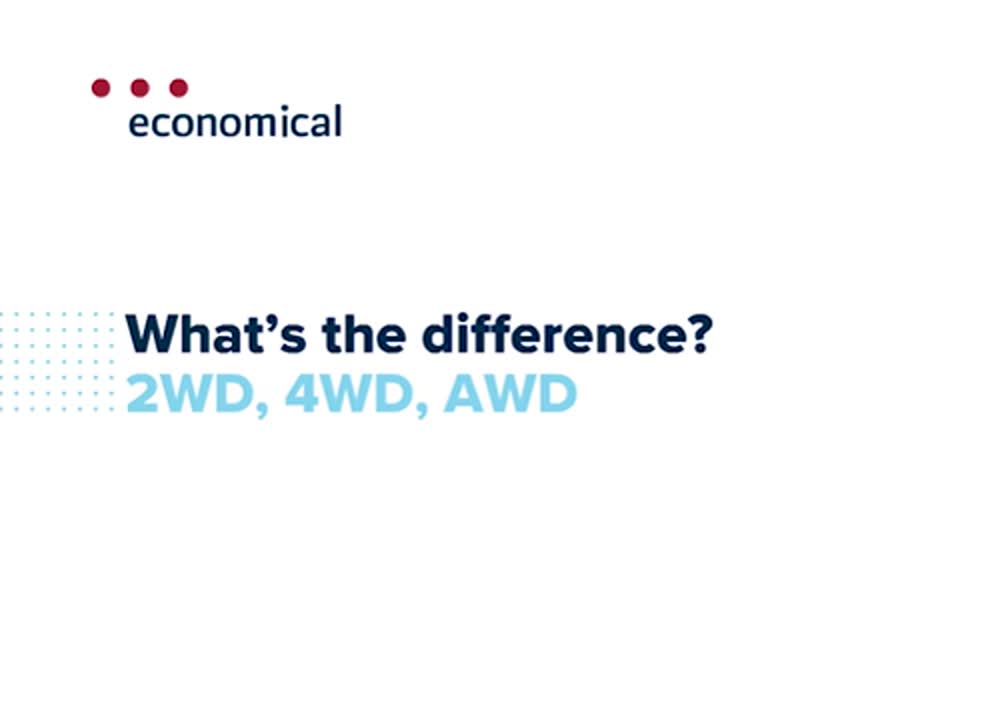Shopping for a new vehicle can be mind-boggling. From advanced driver assistance systems to built-in hands-free technology, there’s a lot to think about — especially if you’re thinking of stepping out of your comfort zone and testing out a class of vehicle that’s different from what you’re used to. Learning the differences between two-wheel drive, four-wheel drive, and all-wheel drive could make your decision a little easier.
Before we get into the details, let’s take a quick look at each drivetrain system in action:

What’s the difference? 2WD, 4WD, AWD
Two-wheel Drive (2WD)
Front-wheel Drive (FWD): On vehicles with front-wheel drive, the engine only sends power to the front wheels.
Rear-wheel Drive (RWD): On vehicles with rear-wheel drive, the engine only sends power to the rear wheels.
Four-wheel Drive (4WD or 4x4)
On vehicles with four-wheel drive, power is split evenly between all four wheels. Some 4WD vehicles send power to the rear wheels until the driver (or the on-board computer system) turns on 4WD to adapt to road conditions. Once 4WD has been turned on, power is delivered to all four of the vehicle’s wheels.
All-wheel Drive (AWD)
On vehicles with all-wheel drive, power is sent to all four wheels at all times. The vehicle’s on-board computer automatically adapts to road conditions by shifting power to the wheels that need it most.
Two-wheel drive
Most passenger vehicles on the road today come standard with two-wheel drive (2WD), which means that the engine powers two of the vehicle’s wheels and the other two are allowed to spin. Since the engine only uses energy to move two wheels and doesn’t have to bear the weight of a hefty four- or all-wheel drive system, vehicles with 2WD are lighter overall, and lightening your load can help you save on fuel.
Vehicles with 2WD are either set up for front-wheel drive (FWD) or rear-wheel drive (RWD), meaning the power is intentionally directed to the front wheels or back wheels, depending on the setup. Let’s compare both systems.
Front-wheel drive
- The most common 2WD system for passenger vehicles on the road today
- Can reduce the vehicle’s total weight since there’s no heavy four- or all-wheel drive system to carry around
- Can make for lower vehicle production costs and better fuel economy since the engine only needs to power two wheels
- The weight of the transmission and engine is balanced directly on top of the front wheels, providing better traction than RWD when you’re climbing hills or driving on slippery roads; this helps prevent tire spinning on snowy and icy streets, too
Rear-wheel drive
- Found mostly on pickup trucks, sports cars, luxury cars, and older SUVs
- Known to provide a quicker initial acceleration because the weight is transferred to the back of the vehicle when you first hit the gas pedal, which increases your rear-wheel traction in dry conditions
- Vehicles with RWD tend to have more even weight distribution, improving the balance and overall performance
- More balanced weight makes it easier for two-wheel drive trucks to travel with an empty bed or lighter load
Four-wheel drive
Four-wheel drive (4WD) systems are often built into pickup trucks and other vehicles intended for off-road driving or low-traction conditions, but they’re becoming increasingly popular in passenger vehicles like SUVs and crossovers. With 4WD, the vehicle’s power is split between all four wheels, giving the driver maximum traction and control on uneven terrain. This can help when you’re climbing steep hills, driving over rocks and boulders, or trying to get your vehicle out of a snowbank.
Today’s 4WD systems are set up to operate on a full-time or permanent basis (meaning all four wheels stay engaged at all times), a part-time or manual basis (meaning the driver has to switch manually between two- and four-wheel drive), or an automatic basis (meaning the vehicle automatically shifts between two- and four-wheel drive depending on road conditions). Generally speaking, vehicles with part-time or automatic 4WD will have better fuel efficiency than vehicles with permanent 4WD, since keeping all four wheels engaged at all times takes more power.
All-wheel drive
If you’ve always thought 4WD and all-wheel drive (AWD) were one and the same, you’re not alone — but while the two terms are often used interchangeably, there is a difference. While 4WD is geared more towards driving off-road and on rugged terrain, AWD is likely better suited to sloppy winter streets, mud, and looser surfaces like sand.
With AWD, all four of your vehicle’s tires can provide traction — so if two of your wheels are stuck (in snow or mud, for example), the other two can still work to get you un-stuck. In most vehicles with AWD, the system stays on at all times, and it’s controlled by a computer system that automatically shifts power to whichever wheels need it most, giving you added traction with no extra effort on your part.
Remember: the right tires make all the difference
It’s a common belief that having all- or four-wheel drive is a substitute for winter tires. But no matter the wheel system you choose, remember that the right tires can make all the difference in your vehicle’s performance — and this is especially true when it comes to winter driving. Installing four matching winter tires makes for a smoother, safer drive and gives you more control on slippery streets.
Now you’re probably wondering which system is best for you — and unfortunately there’s no one-size-fits-all answer; it really depends on your situation, your location, and your everyday driving habits. When thinking about a new vehicle, do your research and test drive each option you’re considering before making your final decision.
To find out how you could qualify for discounts on car insurance or compare coverage options for your new ride, reach out to your group’s insurance broker today.
Did this article help you understand the difference between two-wheel drive, four-wheel drive, and all-wheel drive? Share it on Facebook or Twitter.